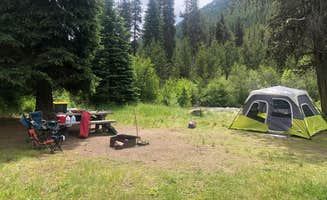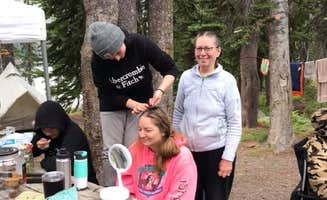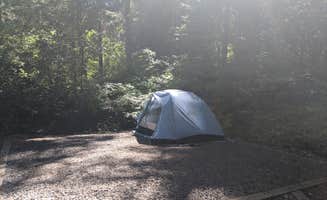Dispersed camping options near Haines, Oregon extend across the Wallowa-Whitman National Forest into the Eagle Cap Wilderness area. The region sits between 3,000-8,000 feet elevation with dry conditions from June through September and heavy snowfall limiting access to many sites during winter months. Forest Service roads provide access to numerous undeveloped camping areas where visitors can set up tents without designated facilities.
What to do
Fishing opportunities: The Thief Valley Reservoir offers rainbow trout fishing in spring, though conditions can be challenging. "A free campsite next to a locally popular rainbow trout fishery. Can be beautiful in the spring, but expect wind. Lake is right next to a wind farm, and you will get blown off the water by noon most days," notes Christopher H. from Thief Valley Reservoir Campground.
Wildlife viewing: The northeastern Oregon mountains support diverse wildlife populations. "Lots of elk and turkeys(?) and a rattlesnake," reports mel B. at Wallowa-Whitman NF 21. Morning and evening hours provide best viewing opportunities.
Hiking to alpine lakes: Access numerous backcountry lakes from base camps. Jim B. describes West Eagle Meadow Campground as having "Great hiking to the lush, broad meadows, which are fed by a creek cascading from the higher elevations." The trail network connects to several alpine lakes for day hiking or backpacking.
What campers like
Accessibility from highway: Quick access points make camping convenient for travelers. "Close spot from the highway for easy camping on a roadtrip! Open forest area spots, pretty quiet," writes Rachel W. about Wallowa-Whitman NF 21 - Dispersed.
Clean facilities: Several campgrounds maintain basic but well-kept amenities. Tony D. notes at Social Security Point Trailhead: "Very well maintained area. Bring your own firewood, the forest floor is extremely clean. There's 4 sites on this road and a restroom at the end."
Privacy options: Camping areas offer varying degrees of seclusion. "Many options for private pull-offs once you drive past established NF campgrounds—likely tough to do without high clearance and/or 4WD when wet," explains Marasha L. regarding dispersed camping opportunities. Some areas require significant driving on forest roads to reach more remote sites.
What you should know
Wind considerations: Several camping areas experience significant wind conditions. Christopher H. mentions, "Expect wind. Lake is right next to a wind farm, and you will get blown off the water by noon most days" at Thief Valley Reservoir. Secure tent stakes are essential gear.
Road conditions: Many camping areas require travel on unpaved roads. According to Jim B., reaching Boulder Park Campground requires effort: "Getting there is a bit of a chore: about 20 miles of dirt track, but we'll worth the effort." High-clearance vehicles are recommended for accessing more remote sites.
Seasonal limitations: Higher elevation sites often have short seasons. "June to September" is the operating season for Moss Springs Campground, with late spring offering particular advantages. Jim B. notes, "Late spring was a perfect time to spend a couple days in the mountain wilderness. Wildflowers we're in bloom and temperatures were moderate during the day and a little cold at night."
Tips for camping with families
Water access spots: Lakefront options provide recreational opportunities. Evan W. describes his experience at Social Security Point: "If you keep driving down it'll take you towards the lake, which is where I camped. Wide open, great sunset views! The lake is dammed, so I assume the water levels vary."
Safety concerns: Be aware of human activity in remote areas. Mel B. cautions about Moss Springs Campground: "When I was out walking I walked past one of their campsites on accident I didn't get close and they started firing a gun in the air. I slept in my car that night and left the next morning."
Site selection: Consider noise factors when choosing the best tent camping near Haines, Oregon. Michael W. advises about roadside sites: "Easy and vacant find for a last minute change to our route. Down side is it's a little too noisy for my taste. Would have driven further down into the woods if I had more time."
Tips from RVers
Vehicle clearance requirements: Assess road conditions for trailer access. Julia R. at Social Security Point shares: "I wanted to pa down by the water, but we are pulling a small camper and the road looked way too rough to go all the way down. There was a car down there, so definitely passable, but not with our camper."
Level sites: Look for stable parking surfaces. Aspen S. notes about dispersed sites: "Good level ground and easy to get back on the road in the morning." This is particularly important for camper vans and small trailers.
Alternative directions: Multiple access routes exist to camping areas. Judy W. provides specific guidance: "From North Powder Hwy 237, you will turn right on Government Gulch Road. When you get to the RR crossing, turn right, cross the tracks onto Telocaset Lane. You can get there from the other side too. Stop at Pondosa Store for a little local history and some snacks."





